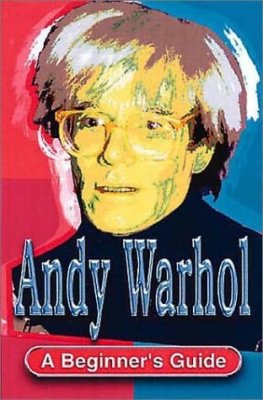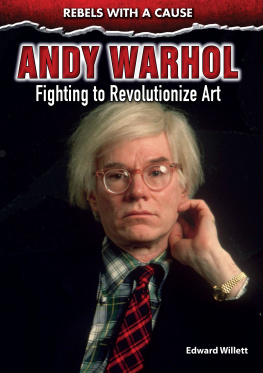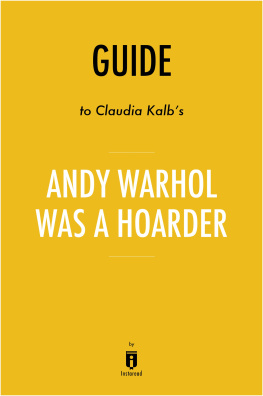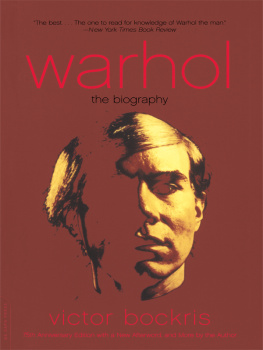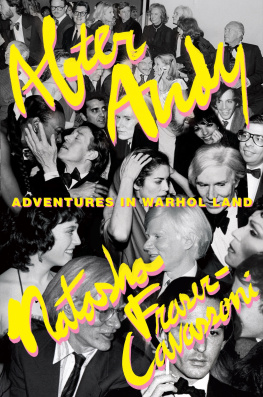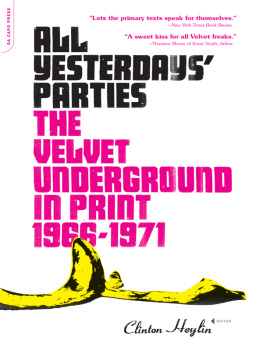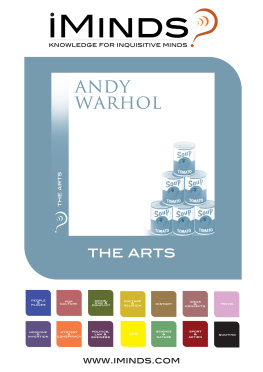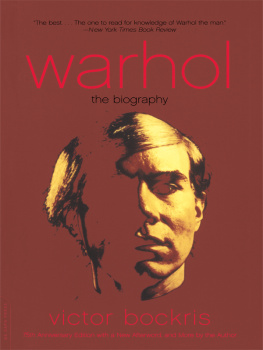Because Steven M. L. Aronson is a great friend, he continued editing this book even after he left publishing. His wit, eccentric insights, and just plain discrimination were invaluable. Line by line, thread by thread, he shaped the scenes that were the sixties.
FOREWORD
This is my personal view of the Pop phenomenon in New York in the 1960s. In writing it, Pat Hackett and I have reconstructed the decade, starting in 60 when I began to paint my first Pop canvases. Its a look back at what life was like then for my friends and meat the paintings, movies, fashions, and music, at the superstars and the relationships that made up the scene at our Manhattan loft, the place known as the Factory.
Andy Warhol
19601963
If Id gone ahead and died ten years ago, Id probably be a cult figure today. By 1960, when Pop Art first came out in New York, the art scene here had so much going for it that even all the stiff European types had to finally admit we were a part of world culture. Abstract Expressionism had already become an institution, and then, in the last part of the fifties, Jasper Johns and Bob Rauschenberg and others had begun to bring art back from abstraction and introspective stuff. Then Pop Art took the inside and put it outside, took the outside and put it inside.
The Pop artists did images that anybody walking down Broadway could recognize in a split secondcomics, picnic tables, mens trousers, celebrities, shower curtains, refrigerators, Coke bottlesall the great modern things that the Abstract Expressionists tried so hard not to notice at all.
One of the phenomenal things about the Pop painters is that they were already painting alike when they met. My friend Henry Geldzahler, curator of twentieth-century art at the Metropolitan Museum before he was appointed official culture czar of New York, once described the beginnings of Pop this way: It was like a science fiction movieyou Pop artists in different parts of the city, unknown to each other, rising up out of the muck and staggering forward with your paintings in front of you.
The person I got my art training from was Emile de Antoniowhen I first met De, I was a commercial artist. In the sixties De became known for his films on Nixon and McCarthy, but back in the fifties he was an artists agent. He connected artists with everything from neighborhood movie houses to department stores and huge corporations. But he only worked with friends; if De didnt like you, he couldnt be bothered.
De was the first person I know of to see commercial art as real art and real art as commercial art, and he made the whole New York art world see it that way, too.
In the fifties John Cage lived near De in the country, up in Pomona, and theyd gotten to be good friends. De produced a concert of Johns there, and thats how he first met Jasper Johns and Bob Rauschenberg. They were both of them on their hands and knees driving nails, building the set, De told me once. They were penniless then, living down on Pearl Street, and theyd take baths when they came out to the country because they had no shower at their placejust a little sink to take a whores bath in.
De got Jasper and Bob work doing windows at Tiffanys for Gene Moore, and for those jobs, rather than use their real names, they both used the same pseudonymMatson Jones.
Bob would have all these commercial ideas for the window displays, and some of them, De once said, could be very bad. But a really interesting one he had was to put stuff down on blueprint paper so youd get a transfer of image. That was around 55 when you couldnt give away one of his paintings. De laughed his hefty laugh, evidently recalling the wide range of Bobs ideas. His displays that were crude were beautiful, but the ones that were sort of arty were terrible. I remember De telling me all this so well, because right at that point he said, I dont know why you dont become a painter, Andyyouve got more ideas than anybody around.
Even a few other people had told me that. I was never sure, though, what my place could be in the whole painting scene. Des support and his open attitude gave me confidence.
After Id done my first canvases, De was the person I wanted to show them to. He could always see the value of something right off. He wouldnt hedge with Where does it come from? or Who did it? He would just look at something and tell you exactly what he thought. Hed often stop by my place for drinks late in the afternoonhe lived right in the neighborhoodand wed usually just gab while I showed him whatever commercial drawings or illustrations I was working on. I loved to listen to De talk. He spoke beautifully, in a deep, easy voice with every comma and period falling into place. (Hed once taught philosophy at the College of William and Mary in Virginia, and literature at the City College of New York.) He made you feel somehow that if you listened to him long enough, youd probably pick up everything youd ever need to know in life. Wed both have a lot of whiskey out of some Limoges cups I had, my serving system at the time. De was a heavy drinker, but I had my fair share, too.
I worked at home in those days. My house was on four floors, including a living area in the basement where the kitchen was and where my mother lived with a lot of cats, all named Sam. (My mother had shown up one night at the apartment where I was living with a few suitcases and shopping bags, and she announced that shed left Pennsylvania for good to come live with my Andy. I told her okay, she could stay, but just until I got a burglar alarm. I loved Mom, but frankly I thought shed get tired of the city pretty quick and miss Pennsylvania and my brothers and their families. But as it turned out, she didnt, and thats when I decided to get this house uptown.) She had the downstairs part and I lived on the upper floors and worked on the parlor floor that was sort of schizohalf like a studio, full of drawings and art supplies, and half like a regular living room. I always kept the blinds drawnthe windows faced west and not much light came in anywayand the walls were wood-paneled. There was a somber feeling about that room. I had some Victorian furniture mixed in with an old wooden carousel horse, a carnival punching machine, Tiffany lamps, a cigar store Indian, stuffed peacocks, and penny arcade machines.


